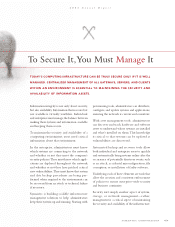Symantec 2004 Annual Report Download - page 8
Download and view the complete annual report
Please find page 8 of the 2004 Symantec annual report below. You can navigate through the pages in the report by either clicking on the pages listed below, or by using the keyword search tool below to find specific information within the annual report.
«6»SYMANTEC CORPORATION
2004 Annual Report
To Manage It,You Must Think Ahead
THROUGH TIGHTER INTEGRATION OF SECURITY AND MANAGEMENT PROCESSES,
CIOs GAIN A BETTER UNDERSTANDING OF THE EXTERNAL THREAT ENVIRONMENT
AND THEIR INTERNAL SECURITY POSTURE. THIS KNOWLEDGE ALLOWS THEM TO
PROACTIVELY PRIORITIZE REMEDIATION EFFORTS AND DELIVER THE APPROPRIATE
TECHNOLOGIES AND TOOLS TO MAINTAIN THE INTEGRITY OF INFORMATION.
The interdependence of security and network
management, systems management, and storage
management is growing.
At the intersection of network management
and systems management, administrators can use
early warnings about threats or vulnerabilities
to trigger specific systems management actions.
For example, they can readily deploy a patch or
reconfigure a system in response to information
about a pending attack.
Administrators can use asset
management
capabilities to discover and organize
all com-
puters in an environment, such as a list of all
currency trading workstations, so they can
prioritize patch deployments and remediation
of vulnerabilities.
Similarly, key integration points exist between
systems management and storage management.
One example might be administrators establish-
ing a rule that will trigger the automatic backup
of all mission-critical machines immediately
before applying a patch, just in case the patch
is faulty and they need to rapidly recover
systems without rebuilding them from scratch.
Finally, both administrators and home users
can use network security information, such as
the existence of pending threats, to change the
backup strategy—where the creation of more
frequent backups can minimize the chance of
losing critical information if attacked and
improve recovery times. They can also restore
machines automatically to their last known
“secure state” after an attack to eliminate the
presence of infected systems.
Through unique and successful collaboration
among these disciplines, Symantec is giving home
users, small businesses, and enterprises alike the
ability to proactively ensure the security and
availability—and therefore the integrity—of
their information.





















